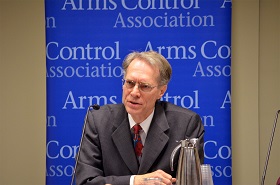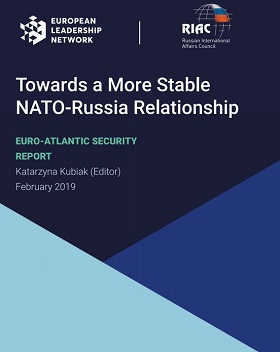Many countries have joined Nuclear Weapons-Free Zone treaties, committing themselves not to develop, produce, or possess nuclear weapons. These zones now cover four of the Earth’s seven continents, incorporating the entire Southern Hemisphere.
In 2017 Pope Francis declared that the elimination of nuclear weapons was a moral and humanitarian imperative, for the first time labeling even nuclear deterrence as immoral and inconsistent with the teachings of the Roman Catholic Church.
A 2017 Treaty on the Prohibition of Nuclear Weapons has been signed by 70 nations and 22 of the 50 needed to ratify before the Ban Treaty enters into effect have already done so.
A group that had been pushing for this treaty, The International Campaign to Abolish Nuclear Weapons, received the Nobel Peace Prize for its efforts in 2017. The group has been disparaged by governments in the nuclear weapons states; even many arms controllers regard it as politically naïve, legally deficient, and a diversion of energy from needed next steps. And yet, it stands as an international rallying point for those who are growing increasingly frustrated with the lack of movement by the nuclear powers to honor their obligations under the Nuclear Non-Proliferation Treaty.
I anticipate that support for nuclear abolitionists will increase in volume. Beatrice Finn, who accepted the Nobel Prize for the International Ban Campaign, challenges arms control advocates to stop using euphemisms like “nuclear deterrence,” which she refers to as: “the threat to commit the mass murder of innocent civilians.” I don’t rule out that the Nuclear Ban Treaty may someday be regarded as an important milestone in the de-legitimization of nuclear weapons. There is another powerful current swirling below the surface of defense policy statements in Washington and Moscow — the battle of the budgets.
In the United States, the House of Representatives, now controlled by Democrats, has the power of the purse. Congressman Adam Smith, Chairman of the House Armed Services Committee, and other Democrats in congressional leadership positions, will not be rubber-stamping White House plans to ramp up spending on nuclear forces while reducing domestic expenditures, ignoring climate change, and driving up the deficit.
In the Russian Federation, there is a similar, if less visible, reality. Without basic reforms, the relative economic position of Russia will continue to decline. Without arms control limits, the cost to Russia of developing and deploying Putin’s miracle weapons will rise steeply. And this time, Putin cannot count on a spike in oil prices to fuel an arms race in pursuit of his great power objectives.
Introduction
I wanted to start with a theme I encountered in a book, entitled The Internationalists, about the Kellogg-Briand “Peace Pact” — the 1928 treaty, signed in Paris, which outlawed war.
I had learned long ago that this agreement was naïve and utterly feckless, spectacularly failing to prevent an even more cataclysmic world war than the one, which spawned it. But the two Yale Law School professors (Hathaway and Shapiro) who wrote this book audaciously contend that the treaty “remade the world,” marking the end of the “Old World Order” and the beginning of a new one. Their intriguing thesis emphasizes the significance of de-legitimizing war as an instrument of national policy, noting the dramatic decline in the lasting conquest of territory following the treaty’s entry into force. The authors contend that the legal foundation established by the Peace Pact set the stage for the institutions put in place following the Second World War.
The authors thus describe a seismic shift, which has not been fully incorporated into the conventional wisdom. If one builds on their insight by adding the changes in strategic thinking forced by the introduction of nuclear weapons, one can better understand where we find ourselves today.
One of the policy tools greatly strengthened in the current internationalist era is arms control — international agreements in which the parties agree to mutual limitations on their freedom of action — curbing arms races and enhancing crisis stability.
In the last chapter of their book, the authors issue an ominous warning: “…the world stands on the brink of renouncing the core commitments of the New World Order…” One of those commitments is to arms control.
I’d like to offer my perspective on what is happening in arms control and what I believe is at stake.
Arms Control Milestones
Let me begin with two dramatic arms control initiatives of the early Twentieth Century, which followed in the wake of “The Great War”. The first is the Washington Naval Treaty of 1922 sought to control the naval arms race by establishing lower ceilings on the number of capital ships in the navies of five nations. It succeeded for a time, but its fatal flaws doomed it to failure within a decade. The second is the 1925 Protocol Against the Use of Poison Gas, on the other hand, was remarkably resilient.
Poison gas had been introduced by Germany in the First World War and was subsequently used by both sides. By the end of the war, 90,000 soldiers had been killed by chemical weapons and another 1.1 million had been injured, many of whom suffered ill effects for the rest of their lives.
The 1925 Protocol won wide international acceptance (although not by the U.S. Senate). The use of poison gas in the 1930s by Italy in Ethiopia and by Japan in China were exceptions. Even Adolph Hitler — a victim of Mustard attacks in WWI) — did not authorize its use into combat in WWII. The worst post-WWI-use of chemical weapons was by Iraq in the 1980s, killing some 20,000 and injuring another 80,000.
The 1997 Chemical Weapons Convention, which extended the Protocol’s ban on use to production and possession is now near-universal, with North Korea as the only significant hold-out. The international community succeeded in eliminating 1,300 metric tons of Syrian CW by the end of 2014. The huge Russian CW inventory has also now been eliminated. The final elimination of U.S. CW stockpiles is scheduled for 2023.
Progress toward reducing nuclear weapons has been a more mixed bag. Worldwide nuclear arsenals have been reduced to some 14,000 warheads from a Cold War peak of 70,000. But the number of nuclear weapons states has increased from five in 1968, when the Nuclear Non-Proliferation Treaty was signed, to nine today.
Only one country, North Korea, has tested nuclear weapons during the last 20 years. But, although most countries, including 3 nuclear weapons states, have ratified the 1996 Comprehensive (Nuclear) Test Ban Treaty, the United States, China, India, Pakistan, Israel, and North Korea have not.
The two largest nuclear powers have agreed to a series of measures, which make their nuclear forces more transparent and communications during crises more reliable. But the world is still subject to misunderstandings and miscalculations during crises, which run the risk of leading to nuclear weapons being used.
Instead of our hair-trigger nuclear posture being eased to provide leaders more time in a crisis to consider what is happening, we have new types of nuclear weapons, which do just the opposite. Of particular concern are Russia’s new, long-range, nuclear-armed and nuclear-powered torpedo, the ground-launched cruise missiles both sides threaten to build, which can carry either conventional or nuclear warheads, and the hypersonic weapons of various types, which are being developed by Russia, the U.S., and China.
End of the INF Treaty
One of the most important arms control developments in recent decades has been the Intermediate-range Nuclear Forces (or INF) Treaty, signed by U.S. President Ronald Reagan and Soviet President Mikhail Gorbachev in 1987. This treaty banned an entire category of nuclear-weapons delivery vehicles — ground-based ballistic and cruise missiles with ranges between 500 and 5,500 km. By the early 1990s, nearly 2,700 US and Russian missiles had been eliminated and three former Soviet states — Belarus, Kazakhstan, and Ukraine — had become parties to the treaty.
Now, 31 years later, the INF Treaty is in its last months. Some Americans say the trouble began in 2013 when the US intelligence concluded that Russia was testing a missile banned by the treaty. Some Russians say the trouble began in 2002, when the US rejected the linkage between strategic offensive and defensive forces and withdrew from that keystone of strategic arms control — the 1972 Anti-Ballistic Missile Treaty. Opponents of the INF Treaty on both sides contend that it has outlived its usefulness, citing the ability of countries outside the treaty, like China, to deploy hundreds of INF missiles that are off-limits to the U.S. and Russia.
What Happened?
Because the INF Treaty has been in the headlines during the last few months and because I spent so much of my professional career working in support of the treaty, I’d like to elaborate a bit on what happened.
The US apparently detected a test launch of a Russian INF-range cruise missile from a fixed launcher back in 2008. It subsequently detected the same missile being tested from mobile launchers at treaty-compliant ranges. But it took three years of additional investigation by U.S. analysts to determine that the test was a treaty-prohibited, ground-launched, land-attack cruise missile. The issue was raised confidentially with the Russians at senior levels in 2013 and publicly in the 2014 US Arms Control Compliance Report. During the next year, the U.S. accused Russia of deploying the suspect system at two locations; Russia counter-charged the U.S. with three ongoing violations of the treaty.
For four years of diplomatic exchanges on the issue, Moscow asked for more details about what Washington thought it had seen, claiming — I believe ingenuously — that it didn’t know what missile or missile tests we were talking about. Finally, at the end of November 2017, the administration provided to the public the Russian identifier of the missile in question: the 9M729 and its manufacturer, Novator.
This changed everything. I will spare you the blow-by-blow I had originally prepared and will cut right to the chase. By the end of 2017, the two most serious compliance issues with the INF Treaty had narrowed to differences of assessment over the capabilities of two deployed weapon systems: Russia’s 9M729 cruise missile and America’s Aegis Ashore missile defense launcher. This parallelism offered the perfect opportunity for seeking an effective and face-saving resolution.
Reciprocal, on-site inspections would allow the parties to get to the bottom of the actual capabilities of the two weapon systems. This would put Russia under pressure to either eliminate its suspect missiles or modify their range capability verifiably. The U.S. would be under pressure to demonstrate that its missile defense launchers could not launch cruise missiles — and/or to make (observable) modifications to the launchers so that Russia could know that they could not be easily adapted to pose an offensive threat. The compliance issue could thus have either been resolved or put in a long process of resolution that would have removed the acute danger to the treaty.
I was not alone in urging such an approach. The “Deep Cuts” Commission of which I’m a member had been studying the issue for several years. This group of 21 non-governmental security experts from the U.S., Germany, and Russia concluded last November that: “… Both sides need to acknowledge the concerns of the other side… Washington and Moscow should agree to reciprocal visits by experts to examine the missiles and the deployment sites in dispute.” Similarly, former Soviet President Gorbachev and former U.S. Secretary of State George Shultz advised in a Washington Post op-ed last December that: “Military and diplomatic officials from the United States and Russia should meet to address and resolve the issues of verification and compliance.”
Instead, the opportunity was squandered. Neither side called for another meeting of the Special Verification Commission, established by the treaty to resolve compliance issues. Neither side called for reciprocal inspections. It was only after the U.S. announced its intention to withdraw that Russia offered to allow the U.S. inspectors to examine their own suspect missile. The U.S. response was that it would only visit to verify the missile system’s elimination.
Both sides have now announced their intention to leave the INF Treaty this year (on August 2). Both sides are threatening to match any new ground-based systems deployed by the other and both imply that additional deployments may also be required, because of the missile build-ups of 3 rd countries.
These arms control developments occur in the context of a sea-change in the attitude of the US and Russia toward international law and treaties. Eight-six years after the world agreed to outlaw war and delegitimize territorial acquisitions gained from war, Russia invaded and annexed Crimea. President Trump announced just last week that the US now recognized Israel’s annexation of the Golan Heights. Israeli Prime Minister Netanyahu pointed to Trump’s action as “proof” that gains from war can be legitimate. “[If territory is] occupied in a defensive war,” he said, “then it’s ours.”
So What now?
Even more distressing than the demise of the INF Treaty is the US and Russian failure to immediately exercise their option to extend the New Strategic Arms Reduction Treaty for five years beyond its 2021 expiration date.
Under the terms of the treaty, this extension can be accomplished by executive agreement between the parties. But when President Putin proposed this early in the new US Administration, President Trump rejected the idea. When Trump’s new National Security Advisor, John Bolton, is now asked about the prospect, he says there is no urgency; there is plenty of time to consider the issue. (Bolton, of course, is known to be extremely hostile to treaties in general and arms control in particular.) Few expect that he will allow a fair hearing from defense and intelligence officials, who are known to be strong advocates of New START extension.
Light in the Darkness
I cannot deny that prospects for a rejuvenation of arms control any time soon appear bleak. But I have lived through serious arms control challenges in the past. In this regards, 1983 often invades my mind. What the Germans dubbed “the year of the missile” fell right in the middle of my tour in Embassy Bonn’s Political Section.
This was the year when President Reagan announced his Strategic Defense Initiative (aka: “Star Wars”) advocating an ambitious program of US strategic missile defenses that would render ICBMs “impotent and obsolete.” (Of course, the Soviets understood this to mean their ICBMs, the heart of Moscow’s deterrent.) This was the year when the Soviet Union shot down Korean Airlines Flight 007 over the Pacific, mistaking it for a “spy plane,” killing all 269 people on board, including a U.S. Congressman. This was the year when “The Day After” movie was shown, a realistic and influential depiction of the effects of a nuclear attack on the U.S. This was the year when NATO’s command post exercise, code-named “Able Archer,” was interpreted by KGB leaders as cover for a real surprise nuclear attack on the Soviet Union. This was the year when the first U.S. INF missiles were deployed in the UK and West Germany and the Soviets walked out of the INF negotiations in Geneva.
Looking for Directions
As I was then, I’m working these days to advance the understanding first voiced by President Reagan in 1984, and joined by President Gorbachev in 1987 that “A nuclear war cannot be won, and must never be fought.” We must continue to seek the ultimate objective of eliminating our nuclear arsenals — even as we focus on the urgent intermediate steps, articulated by President Obama under the rubric of “reducing the role of nuclear weapons in our defenses.” This includes reducing numerical limits on our bloated nuclear arsenals, avoiding the introduction of new types of nuclear weapons, which reduce warning times or contribute to the illusion that the size of a nuclear war can be controlled.
I continue to argue that strategic ballistic missile defense moves us in the opposite direction, a detour from the path toward a nuclear-weapons-free world. Reagan was a nuclear abolitionist, but he did not fully grasp the dynamics of the strategic offense/defense trade-off and the impossibility of relying on missile defenses to erect a reliable umbrella to protect against the hard rain of a nuclear attack. Consequently, it was left to his successor, George H.W. Bush, to conclude the first treaty to reduce strategic offensive arsenals.
And torpedoing the ABM Treaty’s restrictions on strategic defenses have had the opposite effect of what its proponents claimed; it has actually decreased the prospects for reducing the nuclear threat. Abandoning the treaty has constituted a major impetus behind Russia’s crop of new nuclear weapons and helps account for China’s reluctance to engage in limits on its nuclear-armed missiles. At the same time, the tens of billions of dollars spent on missile defenses still have not provided reliable protection against even the limited, nascent nuclear arsenal of North Korea.
Signs of Hope
I have already voiced my doubts that either Vladimir Putin or Donald Trump will significantly advance us toward the arms control objectives I have mentioned. But I do want to identify some light in the darkness. The rest of the world has not lost interest in nuclear arms control; the de-legitimization of nuclear weapons continues apace.
Many countries have joined Nuclear Weapons-Free Zone treaties, committing themselves not to develop, produce, or possess nuclear weapons. These zones now cover four of the Earth’s seven continents, incorporating the entire Southern Hemisphere.
In 2017 Pope Francis declared that the elimination of nuclear weapons was a moral and humanitarian imperative, for the first time labeling even nuclear deterrence as immoral and inconsistent with the teachings of the Roman Catholic Church.
A 2017 Treaty on the Prohibition of Nuclear Weapons has been signed by 70 nations and 22 of the 50 needed to ratify before the Ban Treaty enters into effect have already done so.
A group that had been pushing for this treaty, The International Campaign to Abolish Nuclear Weapons, received the Nobel Peace Prize for its efforts in 2017. The group has been disparaged by governments in the nuclear weapons states; even many arms controllers regard it as politically naïve, legally deficient, and a diversion of energy from needed next steps. And yet, it stands as an international rallying point for those who are growing increasingly frustrated with the lack of movement by the nuclear powers to honor their obligations under the Nuclear Non-Proliferation Treaty.
I anticipate that support for nuclear abolitionists will increase in volume. Beatrice Finn, who accepted the Nobel Prize for the International Ban Campaign, challenges arms control advocates to stop using euphemisms like “nuclear deterrence,” which she refers to as: “the threat to commit the mass murder of innocent civilians.” I don’t rule out that the Nuclear Ban Treaty may someday be regarded as an important milestone in the de-legitimization of nuclear weapons. There is another powerful current swirling below the surface of defense policy statements in Washington and Moscow — the battle of the budgets.
In the United States, the House of Representatives, now controlled by Democrats, has the power of the purse. Congressman Adam Smith, Chairman of the House Armed Services Committee, and other Democrats in congressional leadership positions, will not be rubber-stamping White House plans to ramp up spending on nuclear forces while reducing domestic expenditures, ignoring climate change, and driving up the deficit.
In the Russian Federation, there is a similar, if less visible, reality. Without basic reforms, the relative economic position of Russia will continue to decline. Without arms control limits, the cost to Russia of developing and deploying Putin’s miracle weapons will rise steeply. And this time, Putin cannot count on a spike in oil prices to fuel an arms race in pursuit of his great power objectives.
I will end with another quote from the recent article by Gorbachev and Shultz: “Equally difficult problems have been solved in the past once the two sides put their minds to it. We are confident this can be done again.”
May it be so.
First published in the Arms Control Association.








